Question 1:
Find the coordinates of the point which divides the join of (− 1, 7) and (4, − 3) in the ratio 2:3.
Answer:
Let P(x, y) be the required point. Using the section formula, we obtain

Therefore, the point is (1, 3).
Exams Question Papers General Knowledge Election Directory
Question 1:
Find the coordinates of the point which divides the join of (− 1, 7) and (4, − 3) in the ratio 2:3.
Answer:
Let P(x, y) be the required point. Using the section formula, we obtain

Therefore, the point is (1, 3).
Question 9:
If Q (0, 1) is equidistant from P (5, − 3) and R (x, 6), find the values of x. Also find the distance QR and PR.
Answer:
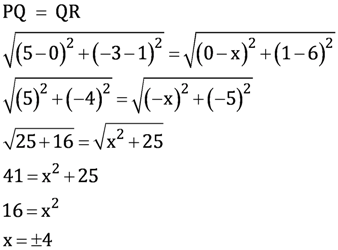
Therefore, point R is (4, 6) or (−4, 6).
When point R is (4, 6),
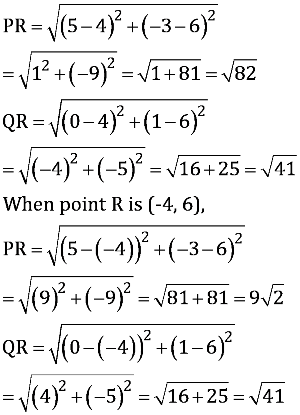
Question 8:
Find the values of y for which the distance between the points P (2, − 3) and Q (10, y) is 10 units.
Answer:
It is given that the distance between (2, −3) and (10, y) is 10.
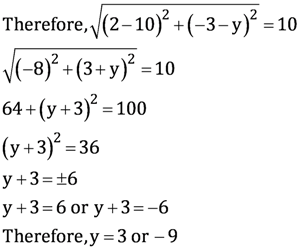
Question 7:
Find the point on the x-axis which is equidistant from (2, − 5) and (− 2, 9).
Answer:
We have to find a point on x-axis. Therefore, its y-coordinate will be 0.
Let the point on x-axis be (x,0).
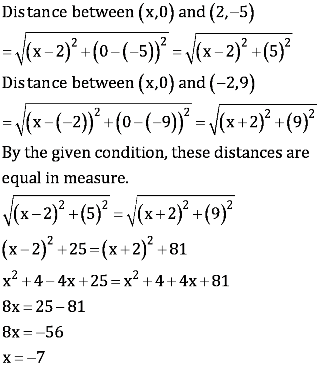
Therefore, the point is (− 7, 0).
Question 6:
Name the type of quadrilateral formed, if any, by the following points, and give reasons for your answer:
(i) (− 1, − 2), (1, 0), (− 1, 2), (− 3, 0)
(ii) (− 3, 5), (3, 1), (0, 3), (− 1, − 4)
(iii) (4, 5), (7, 6), (4, 3), (1, 2)
Answer:
(i) Let the points (−1, −2), (1, 0), (−1, 2), and (−3, 0) be representing the vertices A, B, C, and D of the given quadrilateral respectively.
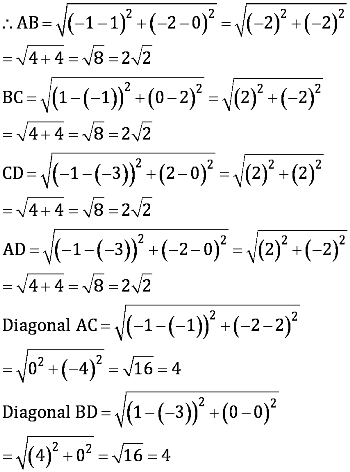
It can be observed that all sides of this quadrilateral are of the same length and also, the diagonals are of the same length. Therefore, the given points are the vertices of a square.
(ii)Let the points (− 3, 5), (3, 1), (0, 3), and (−1, −4) be representing the vertices A, B, C, and D of the given quadrilateral respectively.

It can be observed that all sides of this quadrilateral are of different lengths.
Therefore, it can be said that it is only a general quadrilateral, and not specific such
as square, rectangle, etc.
(iii)Let the points (4, 5), (7, 6), (4, 3), and (1, 2) be representing the vertices A, B, C, and D of the given quadrilateral respectively.
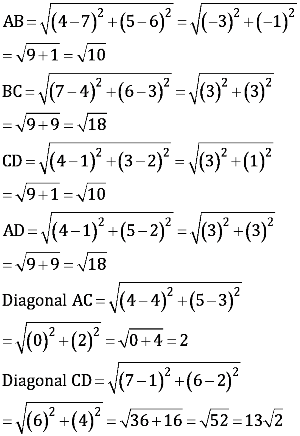
It can be observed that opposite sides of this quadrilateral are of the same length.
However, the diagonals are of different lengths. Therefore, the given points are the vertices of a parallelogram.
Question 5:
In a classroom, 4 friends are seated at the points A, B, C and D as shown in the following figure. Champa and Chameli walk into the class and after observing for a few minutes Champa asks Chameli, “Don’t you think ABCD is a square?” Chameli disagrees.
Using distance formula, find which of them is correct.
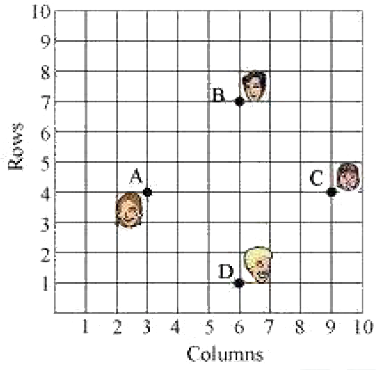
Answer:
It can be observed that A (3, 4), B (6, 7), C (9, 4), and D (6, 1) are the positions of these 4 friends.

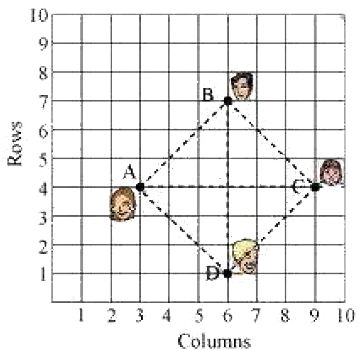
It can be observed that all sides of this quadrilateral ABCD are of the same length and also the diagonals are of the same length.
Therefore, ABCD is a square and hence, Champa was correct.
Question 4:
Check whether (5, − 2), (6, 4) and (7, − 2) are the vertices of an isosceles triangle.
Answer:
Let the points (5, −2), (6, 4), and (7, −2) are representing the vertices A, B, and C of the given triangle respectively.

As two sides are equal in length, therefore, ABCis an isosceles triangle.
Question 10:
Find a relation between x and y such that the point (x, y) is equidistant from the point (3, 6) and (− 3, 4).
Answer:
Point (x, y) is equidistant from (3, 6) and (−3, 4).

Question 1:
Find the distance between the following pairs of points:
(i) (2, 3), (4, 1) (ii) (−5, 7), (−1, 3) (iii) (a, b), (− a, − b)
Answer:
(i) Distance between the two points is given by
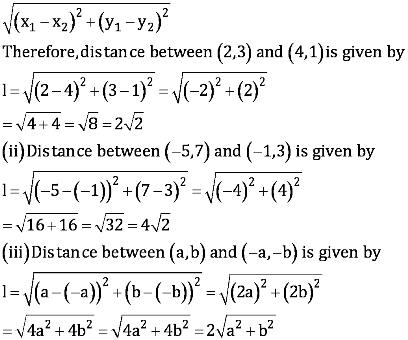
Question 10:
Nazima is fly fishing in a stream. The tip of her fishing rod is 1.8 m above the surface of the water and the fly at the end of the string rests on the water 3.6 m away and 2.4 m from a point directly under the tip of the rod. Assuming that her string (from the tip of her rod to the fly) is taut, ho much string does she have out (see this figure)? If she pulls in the string at the rate of 5 cm per second, what will be the horizontal distance of the fly from her after 12 seconds?

Answer:

Let AB be the height of the tip of the fishing rod from the water surface. Let BC be the horizontal distance of the fly from the tip of the fishing rod.
Then, AC is the length of the string.
AC can be found by applying Pythagoras theorem in ΔABC.
AC2 = AB2 + BC2
AB2 = (1.8 m)2 + (2.4 m)2
AB2 = (3.24 + 5.76) m2
AB2 = 9.00 m2
⇒ AB = √9 m = 3 m
Thus, the length of the string out is 3 m.
She pulls the string at the rate of 5 cm per second.
Therefore, string pulled in 12 seconds = 12 × 5 = 60 cm = 0.6 m

Let the fly be at point D after 12 seconds.
Length of string out after 12 seconds is AD.
AD = AC − String pulled by Nazima in 12 seconds
= (3.00 − 0.6) m
= 2.4 m
In ΔADB,
AB2 + BD2 = AD2
(1.8 m)2 + BD2 = (2.4 m)2
BD2 = (5.76 − 3.24) m2 = 2.52 m2
BD = 1.587 m
Horizontal distance of fly = BD + 1.2 m
= (1.587 + 1.2) m
= 2.787 m
= 2.79 m
Question 9:
In the given figure, D is a point on side BC of ΔABC such that BD/CD = AB /AC. Prove that AD is the bisector of ∠BAC.

Answer:
Let us extend BA to P such that AP = AC. Join PC.

It is given that,
BD/CD = AB/AC
⇒ BD/CD = AP/AC
By using the converse of basic proportionality theorem, we obtain AD || PC
⇒ ∠BAD = ∠APC (Corresponding angles) … (1)
And, ∠DAC = ∠ACP (Alternate interior angles) … (2)

By construction, we have
AP = AC
⇒ ∠APC = ∠ACP … (3)
On comparing equations (1), (2), and (3), we obtain
∠BAD = ∠APC
⇒ AD is the bisector of the angle BAC
Question 8:
In the given figure, two chords AB and CD of a circle intersect each other at the point P (when produced) outside the circle. Prove that
(i) ΔPAC ∼ ΔPDB (ii) PA.PB = PC.PD

Answer:
(i) In ΔPAC and ΔPDB,
∠P = ∠P (Common)
∠PAC = ∠PDB (Exterior angle of a cyclic quadrilateral is ∠PCA = ∠PBD equal to the opposite interior angle)
∴ ΔPAC ∼ ΔPDB
(ii)We know that the corresponding sides of similar triangles are proportional.

Question 7:
In the given figure, two chords AB and CD intersect each other at the point P. prove that:
(i) ΔAPC ∼ ΔDPB (ii) AP.BP = CP.DP

Answer:
Let us join CB.

(i) In ΔAPC and ΔDPB,
∠APC = ∠DPB (Vertically opposite angles)
∠CAP = ∠BDP (Angles in the same segment for chord CB)
ΔAPC ∼ ΔDPB (By AA similarity criterion)
(ii) We have already proved that
ΔAPC ∼ ΔDPB
We know that the corresponding sides of similar triangles are proportional.

Question 6:
Prove that the sum of the squares of the diagonals of parallelogram is equal to the sum of the squares of its sides.
Answer:

Let ABCD be a parallelogram.
Let us draw perpendicular DE on extended side AB, and AF on side DC.
Applying Pythagoras theorem in ΔDEA, we obtain
DE2 + EA2 = DA2 … (i)
Applying Pythagoras theorem in ΔDEB, we obtain
DE2 + EB2 = DB2
DE2 + (EA + AB)2 = DB2
(DE2 + EA2) + AB2 + 2EA × AB = DB2
DA2 + AB2 + 2EA × AB = DB2 … (ii)
Applying Pythagoras theorem in ΔADF, we obtain
AD2 = AF2 + FD2
Applying Pythagoras theorem in ΔAFC, we obtain
AC2 = AF2 + FC2
= AF2 + (DC − FD)2
= AF2 + DC2 + FD2 − 2DC × FD
= (AF2 + FD2) + DC2 − 2DC × FD
AC2 = AD2 + DC2 − 2DC × FD … (iii)
Since ABCD is a parallelogram,
AB = CD … (iv)
And, BC = AD … (v)
In ΔDEA and ΔADF,
∠DEA = ∠AFD (Both 90°)
∠EAD = ∠ADF (EA || DF)
AD = AD (Common)
∴ ;EAD ≅ FDA (AAS congruence criterion)
⇒ EA = DF … (vi)
Adding equations (i) and (iii), we obtain
DA2 + AB2 + 2EA × AB + AD2 + DC2 − 2DC × FD = DB2 + AC2
DA2 + AB2 + AD2 + DC2 + 2EA × AB − 2DC × FD = DB2 + AC2
BC2 + AB2 + AD2 + DC2 + 2EA × AB − 2AB × EA = DB2 + AC2
[Using equations (iv) and (vi)]
AB2 + BC2 + CD2 + DA2 = AC2 + BD2
Question 5:
In the given figure, AD is a median of a triangle ABC and AM ⊥ BC. Prove that:


Answer:
(i) Applying Pythagoras theorem in ΔAMD, we obtain
AM2 + MD2 = AD2 … (1)
Applying Pythagoras theorem in ΔAMC, we obtain
AM2 + MC2 = AC2
AM2 + (MD + DC)2 = AC2
(AM2 + MD2) + DC2 + 2MD.DC = AC2
AD2 + DC2 + 2MD.DC = AC2 [Using equation (1)]
Using the result, DC = BC/2, we obtain

(ii) Applying Pythagoras theorem in ΔABM, we obtain
AB2 = AM2 + MB2
= (AD2 − DM2) + MB2
= (AD2 − DM2) + (BD − MD)2
= AD2 − DM2 + BD2 + MD2 − 2BD × MD
= AD2 + BD2 − 2BD × MD

(iii)Applying Pythagoras theorem in ΔABM, we obtain
AM2 + MB2 = AB2 … (1)
Applying Pythagoras theorem in ΔAMC, we obtain
AM2 + MC2 = AC2 … (2)
Adding equations (1) and (2), we obtain
2AM2 + MB2 + MC2 = AB2 + AC2
2AM2 + (BD − DM)2 + (MD + DC)2 = AB2 + AC2
2AM2+BD2 + DM2 − 2BD.DM + MD2 + DC2 + 2MD.DC = AB2 + AC2
2AM2 + 2MD2 + BD2 + DC2 + 2MD (− BD + DC) = AB2 + AC2

Question 4:
In the given figure, ABC is a triangle in which ∠ABC < 90° and AD ⊥ BC. Prove that AC2 = AB2 + BC2 − 2BC.BD.

Answer:
Applying Pythagoras theorem in ΔADB, we obtain
AD2 + DB2 = AB2
⇒ AD2 = AB2 − DB2 … (1)
Applying Pythagoras theorem in ΔADC, we obtain
AD2 + DC2 = AC2
AB2 − BD2 + DC2 = AC2 [Using equation (1)]
AB2 − BD2 + (BC − BD)2 = AC2
AC2 = AB2 − BD2 + BC2 + BD2 −2BC × BD
= AB2 + BC2 − 2BC × BD
Question 3:
In the given figure, ABC is a triangle in which ∠ABC> 90° and AD ⊥ CB produced. Prove that AC2 = AB2 + BC2 + 2BC.BD.

Answer:
Applying Pythagoras theorem in ΔADB, we obtain
AB2 = AD2 + DB2 … (1)
Applying Pythagoras theorem in ΔACD, we obtain
AC2 = AD2 + DC2
AC2 = AD2 + (DB + BC)2
AC2 = AD2 + DB2 + BC2 + 2DB × BC
AC2 = AB2 + BC2 + 2DB × BC [Using equation (1)]
Question 2:
In the given figure, D is a point on hypotenuse AC of ΔABC, DM ⊥ BC and DN ⊥ AB, Prove that:
(i) DM2 = DN.MC
(ii) DN2 = DM.AN

Answer:
(i)Let us join DB.

We have, DN || CB, DM || AB, and ∠B = 90°
∴ DMBN is a rectangle
∴ DN = MB and DM = NB
The condition to be proved is the case when D is the foot of the perpendicular drawn from B to AC.
∴ ∠CDB = 90°
⇒ ∠2 + ∠3 = 90° … (1)
In ΔCDM,
∠1 + ∠2 + ∠DMC = 180°
⇒ ∠1 + ∠2 = 90° … (2)
In ΔDMB,
∠3 + ∠DMB + ∠4 = 180°
⇒ ∠3 + ∠4 = 90° … (3)
From equation (1) and (2), we obtain
∠1 = ∠3
From equation (1) and (3), we obtain
∠2 = ∠4
In ΔDCM and ΔBDM,
∠1 = ∠3 (Proved above)
∠2 = ∠4 (Proved above)
∴ ΔDCM ∼ ΔBDM (AA similarity criterion)
BM/DM = DM/MC
⇒ DN/DM = DM/MC (BM = DN)
⇒ DM2 = DN × MC
(ii) In right triangle DBN,
∠5 + ∠7 = 90° … (4)
In right triangle DAN,
∠6 + ∠8 = 90° … (5)
D is the foot of the perpendicular drawn from B to AC.
∴ ∠ADB = 90°
⇒ ∠5 + ∠6 = 90° … (6)
From equation (4) and (6), we obtain
∠6 = ∠7
From equation (5) and (6), we obtain
∠8 = ∠5
In ΔDNA and ΔBND,
∠6 = ∠7 (Proved above)
∠8 = ∠5 (Proved above)
∴ ΔDNA ∼ ΔBND (AA similarity criterion)
⇒ AN/DN = DN/NB
⇒ DN2 = AN × NB
⇒ DN2 = AN × DM (As NB = DM)
Question 1:
In the given figure, PS is the bisector of ∠QPR of ΔPQR. Prove that QS/SR = PQ/PR.

Answer:

Let us draw a line segment RT parallel to SP which intersects extended line segment QP at point T.
Given that, PS is the angle bisector of ∠QPR.
∠QPS = ∠SPR … (1)
By construction,
∠SPR = ∠PRT (As PS || TR) … (2)
∠QPS = ∠QTR (As PS || TR) … (3)
Using these equations, we obtain
∠PRT = ∠QTR
∴ PT = PR
By construction,
PS || TR
By using basic proportionality theorem for ΔQTR,
QS/SR = QP/PT
⇒ QS/SR = PQ/PR (PT = TR)
Question 17:
Tick the correct answer and justify: In ΔABC, AB = 6√3 cm, AC = 12 cm and BC = 6 cm.
The angle B is:
(A) 120° (B) 60°
(C) 90° (D) 45°
Answer:

Given that, AB = 6√3 cm , AC = 12 cm, and BC = 6 cm
It can be observed that
AB2 = 108
AC2 = 144
And, BC2 = 36
AB2 +BC2 = AC2
The given triangle, ΔABC, is satisfying Pythagoras theorem.
Therefore, the triangle is a right triangle, right-angled at B.
∴ ∠B = 90°
Hence, the correct answer is (C).